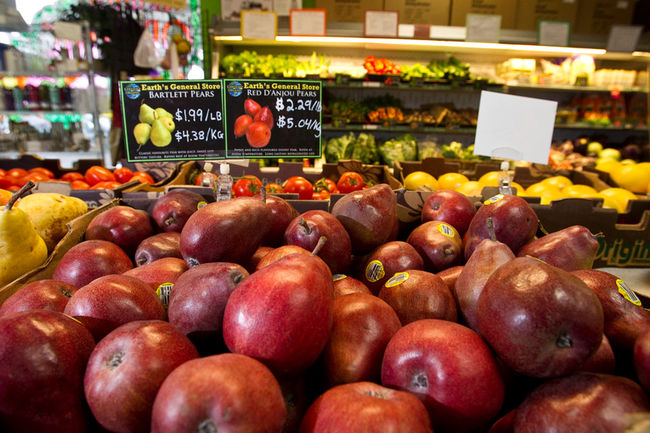
Affordable organic food
KINGSTON – It’s often a struggle for families to make meals affordable. North American families spend less than 20 per cent of their budget on food, while European families spend up to 50 per cent of their budget on food. Not surprisingly, we also eat more packaged foods and less fresh foods.
Finding a balance between food affordability and living expenses can be challenging and adding in organic foods can create even more stress for meal time.
Among the ways to add healthy food to our diet is by eating locally and organically produced vegetables, fruits, dairy and meats. Many of the foods produced locally and organically use little or no pesticides at all. You can find these foods at local grocery stores and farmers’ markets.
For a family with children, the cost of local and organic food can often seem overwhelming and expensive. While this may be true, I urge you to consider the health benefits of eating a healthier and toxin-free diet. We need to look at food holistically and as a preventative medicine as opposed to an item we consume just to keep our bellies full. Food has the ability to heal our body and offer us optimal health — mentally, physically and emotionally.
Conventional foods are exposed to an array of pesticides, GMOs, herbicides and other toxic chemicals. While these toxins in isolation and alone do not amount to much, combined with all other toxins they can add up significantly. For example, if you eat only potatoes doused in pesticides this may not cause havoc or harm to your body; however, when you combine your pesticide-laden potatoes with your carrots, celery, apples, lettuce, meats and more it amounts to quantities of toxins that our body is not able handle. We see this through autoimmune disorders, mental health and illnesses presenting themselves in increased numbers in society. Take the pesticides, antiobiotics and chemicals in food and add skin care products, air quality and toxins from the “stuff” that lives in our homes with us (couches, mattresses, sheets, clothing, etc) and you have a recipe for a toxic slew in your body.
What does that mean and how do we go forward?
One of the most basic and achievable ways to start eliminating toxins in your body is through your food. By slowly making changes to your grocery list and buying habits you can start to change the foods entering your body and make big changes to your health and the health of your family.
Here are some easy to strategies for making oganic and local eating more affordable for your family
• Start with an inventory of your fridge and pantry. What foods are in there? What foods do you eat most frequently? Take note of the foods you eat most often and those that you eat less often. The foods that you are eating daily or several times a week are the first foods you should consider finding organic alternatives for. For instance, in our home we eat lots of potatoes so we almost always purchase organic potatoes. We don’t eat a lot of fresh strawberries, especially in the winter, so if we need fresh strawberries for a recipe I will often pick up the conventional variety. Start with one food at a time and only when you have used the remaining stock you have.
• Purchase fruits and vegetables from the Dirty Dozen — a list of fruits and vegetables with the highest levels of pesticides (www.ewg.org/foodnews/dirty_dozen_list.php). When our family shops for veggies and fruits we try our best to purchase organic varieties from the Dirty Dozen list. Strawberries, apples, peaches, celery, grapes, tomatoes, cucumbers and more fill this list. On the other side of the list they also have the Clean 15 — 15 fruits and veggies that have the least amount of pesticides. If we can’t find an organic variety of the veggies and fruits on the Dirty Dozen we will often choose another vegetable or fruit as a replacement that is on the Clean 15 list. Instead of having apples that week we will opt for bananas and melon. There is an app for the Dirty Dozen to make your organic shopping choices more convenient.
• Freeze, can, preserve or dehydrate your vegetables and fruit from the summer seasons. We will head to our local organic farm and pick/collect as much vegetables and fruits as we can. Then we will come home to can, preserve, dehydrate or freeze as much as we possibly can. Typically the venture ends with us freezing the majority of the fruits and veggies because we don’t have the time to preserve and can them all. We reap the benefits of our efforts in the middle of winter as we enjoy local, organic smoothies and sauces.
• Consider buying in bulk and direclty from farmers. The cost up front for this method can be more challenging for many families but well worth the investment. Purchasing bulk bags of flour and rice, a half cow or a full pig will save you a significant amount of money and you will have better quality food.
• Make your own foods instead of purchasing prepackaged food. This improves our family’s food budget significantly. I make my own muffins, granola bars, puddings, soups, chili, salads, etc. While this does cost me in terms of time, I am happy to offer my time in the evenings and weekends preparing healthy, whole foods for my children.
Remember that this isn’t an all-or-nothing choice. Taking one food at a time and doing as much as you can does make a difference.
* This article was originally written and published on http://www.thewhig.com/2017/01/19/affordable-organic-food

